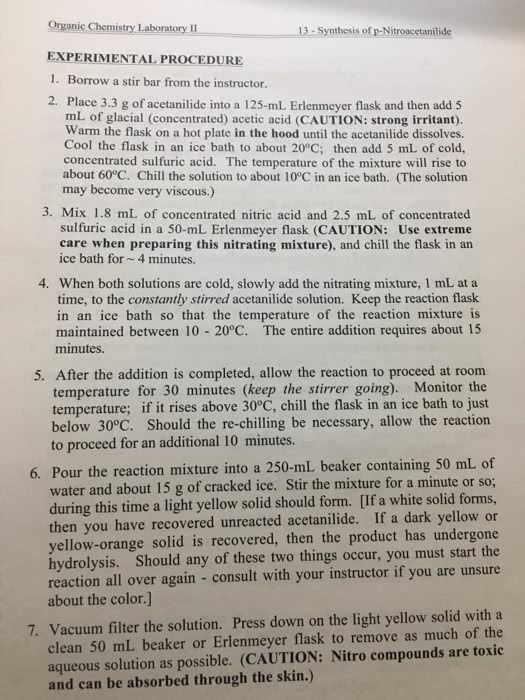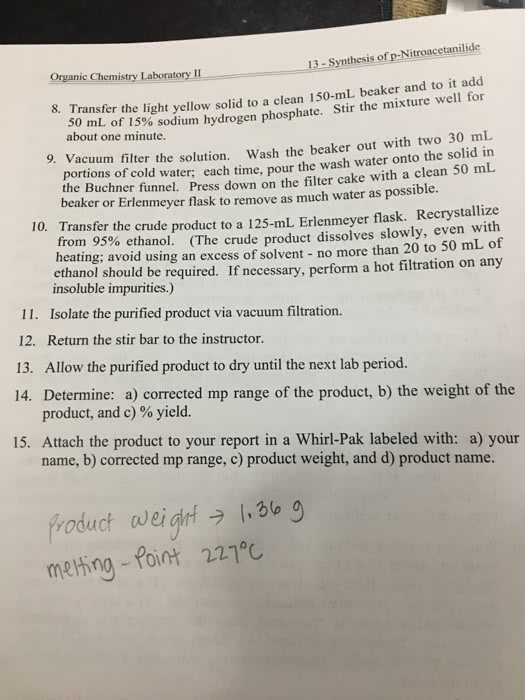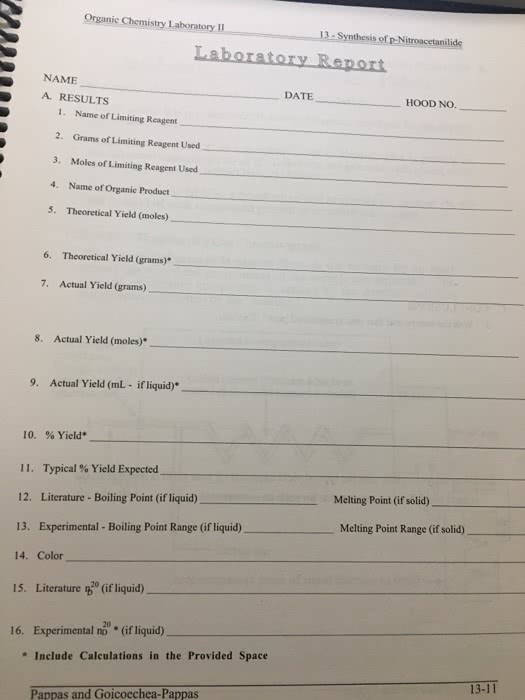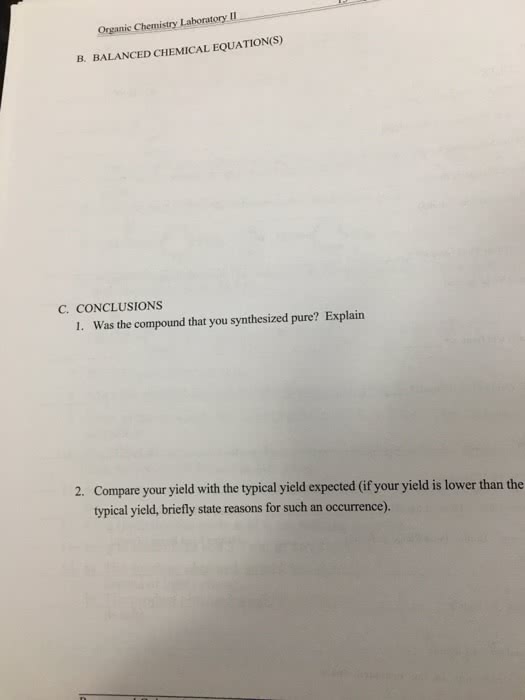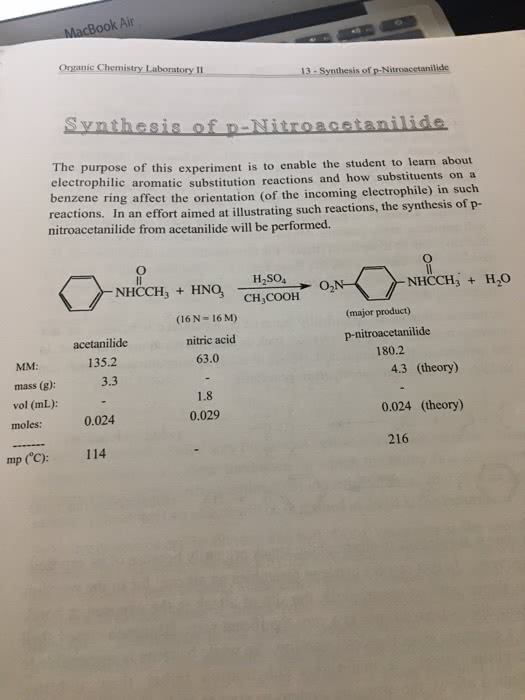Hello I need help with calculating the theoretical yields. All the information are given below. The images of the equations couldn't be uploaded.
Nitration of Methyl benzoate, acetanilide and Competition
Experimental Procedure:
Nitration of Methyl Benzoate
A. Preparation of the Nitrating Agent
1. Support a small test tube in an Erlenmeyer flask.
2. Using the small plastic dropping bottles, add 20 drops of concentrated acetic acid, 40 drops of
concentrated sulfuric acid, and 16 drops of concentrated nitric acid.
3. Swirl the mixture and set aside to be used later.
B. Nitration of Methyl Benzoate
4. Place a magnetic stir bar in a 25 mL Erlenmeyer flask and add 0.2 g of methyl benzoate.
Methyl benzoate is a liquid so place the Erlenmeyer flask on the balance, zero the balance, and add drop wise until the mass is 0.2 g (record exact mass used if slightly different than 0.2 g).
5. Add 20 drops of concentrated acetic acid and 40 drops of concentrated sulfuric acid.
Place the flask in an ice bath (small beaker with some ice and a little water) and stir for several minutes to dissolve the methyl benzoate (a homogeneous solution is achieved).
While stirring, use a glass pipette to add the solution of the nitrating agent drop wise over 3 minutes.
Remove the reaction from the ice bath and stir for an additional 20 minutes.
After 20 minutes, add a few pieces of crushed ice directly to the reaction mixture.
After the ice has melted, slowly 5 mL of saturated sodium bicarbonate.
Collect the product using vacuum filtration and wash the final product with a 5 mL of cold water and allow it to dry under vacuum for several minutes.
Record the mass of the final product, measure the melting point, calculate the percent yield and obtain an IR spectrum.
Nitration of Methyl benzoate, acetanilide and Competition
Nitration of Acetanilide
A. Preparation of the Nitrating Agent
1. Support a small test tube in an Erlenmeyer flask.
2. Using the small plastic dropping bottles, add 20 drops of concentrated acetic acid, 40 drops of concentrated sulfuric acid, and 16 drops of concentrated nitric acid.
3. Swirl the mixture and set aside to be used later.
B. Nitration of Acetanilide
4. Place a magnetic stir bar in a 25 mL Erlenmeyer flask and add 0.2 g of acetanilide.
5. Add 20 drops of concentrated acetic acid and 40 drops of concentrated sulfuric acid.
6. Place the flask in an ice bath (small beaker with some ice and a little water) and stir for several minutes to dissolve the acetanilide.
7. While stirring, use a glass pipette to add the solution of the nitrating agent drop wise over 3 minutes.
Remove the reaction from the ice bath and stir for an additional 20 minutes.
After 20 minutes, add a few pieces of crushed ice directly to the reaction mixture.
After the ice has melted, slowly 5 mL of saturated sodium bicarbonate.
Collect the product using vacuum filtration and wash the final product with a 5 mL of cold water and allow it to dry under vacuum for several minutes.
Record the mass of the final product, measure the melting point, calculate the percent yield and obtain an IR spectrum.
Nitration of Methyl benzoate, acetanilide and Competition
Competition Experiment (Methyl Benzoate vs. Aectanilide)
A. Preparation of the nitrating agent
Support a small test tube in an Erlenmeyer flask.
Using the small plastic dropping bottles, add 2 drops of concentrated nitric acid, 10 drops of concentrated acetic acid, and 20 drops of concentrated sulfuric acid.
Gently swirl the mixture and set aside to be used later.
B. Competition Experiment
Set a 25 mL Erlenmeyer flask on the balance, zero the balance and add 0.1 g methyl benzoate (add this reagent first because it is a liquid).
Measure 0.1 g acetanilide (using weighing paper) and add this to the 25 mL Erlenmeyer flask containing the methyl benzoate.
Add 10 drops of concentrated acetic acid and 20 drops of concentrated sulfuric acid.
Place a magnetic stir bar in the flask and begin stirring.
Place the Erlenmeyer flask in an ice bath and add the solution of the nitrating agent drop wise over 5 minutes.
Remove the reaction from the ice bath and stir for an additional 10 minutes.
After 10 minutes, add a few pieces of crushed ice directly to the reaction mixture.
After the ice has melted, slowly 5 mL of saturated sodium bicarbonate.
Collect the product using vacuum filtration and wash the final product with a 5 mL of cold water and allow it to dry under vacuum for several minutes.
Record the mass of the final product, measure the melting point, calculate the percent
yield and obtain an IR spectrum.
Nitration of Methyl benzoate, acetanilide and Competition
Pre Lab Questions
1. Fill in the appropriate data in the tables below and calculate the theoretical yield. (Use
the amounts of materials that will be used from the experimental section above)
Molecular Weight
amount
Theoretical yield
moles
density/concentration
(if applicable)
Equivalents
Molecular Weight
amount
Theoretical yield
moles
density/concentration
(if applicable)
Equivalents
Molecular Weight
amount
Theoretical Yield
Theoretical Yield
moles
density/conc
Equivalents
2. Look up the melting point of methyl-2-nitrobenzoate, methyl-3-nitrobenzoate, methyl-
4-nitrobenzoate, 2-nitroacetanilide, and 4-nitroacetanilide (and record the reference(s)
used)
3. Which product is expected from the nitration of methyl benzoate based on the directing
nature of the ester?
4. Based on the predicted reactivities of methyl benzoate compared to acetanilide, what
product is expected from the competition experiment.
Hello I need help with calculating the theoretical yields. All the information are given below. The images of the equations couldn't be uploaded.
Nitration of Methyl benzoate, acetanilide and Competition
Experimental Procedure:
Nitration of Methyl Benzoate
A. Preparation of the Nitrating Agent
1. Support a small test tube in an Erlenmeyer flask.
2. Using the small plastic dropping bottles, add 20 drops of concentrated acetic acid, 40 drops of
concentrated sulfuric acid, and 16 drops of concentrated nitric acid.
3. Swirl the mixture and set aside to be used later.
B. Nitration of Methyl Benzoate
4. Place a magnetic stir bar in a 25 mL Erlenmeyer flask and add 0.2 g of methyl benzoate.
Methyl benzoate is a liquid so place the Erlenmeyer flask on the balance, zero the balance, and add drop wise until the mass is 0.2 g (record exact mass used if slightly different than 0.2 g).
5. Add 20 drops of concentrated acetic acid and 40 drops of concentrated sulfuric acid.
Place the flask in an ice bath (small beaker with some ice and a little water) and stir for several minutes to dissolve the methyl benzoate (a homogeneous solution is achieved).
While stirring, use a glass pipette to add the solution of the nitrating agent drop wise over 3 minutes.
Remove the reaction from the ice bath and stir for an additional 20 minutes.
After 20 minutes, add a few pieces of crushed ice directly to the reaction mixture.
After the ice has melted, slowly 5 mL of saturated sodium bicarbonate.
Collect the product using vacuum filtration and wash the final product with a 5 mL of cold water and allow it to dry under vacuum for several minutes.
Record the mass of the final product, measure the melting point, calculate the percent yield and obtain an IR spectrum.
Nitration of Methyl benzoate, acetanilide and Competition
Nitration of Acetanilide
A. Preparation of the Nitrating Agent
1. Support a small test tube in an Erlenmeyer flask.
2. Using the small plastic dropping bottles, add 20 drops of concentrated acetic acid, 40 drops of concentrated sulfuric acid, and 16 drops of concentrated nitric acid.
3. Swirl the mixture and set aside to be used later.
B. Nitration of Acetanilide
4. Place a magnetic stir bar in a 25 mL Erlenmeyer flask and add 0.2 g of acetanilide.
5. Add 20 drops of concentrated acetic acid and 40 drops of concentrated sulfuric acid.
6. Place the flask in an ice bath (small beaker with some ice and a little water) and stir for several minutes to dissolve the acetanilide.
7. While stirring, use a glass pipette to add the solution of the nitrating agent drop wise over 3 minutes.
Remove the reaction from the ice bath and stir for an additional 20 minutes.
After 20 minutes, add a few pieces of crushed ice directly to the reaction mixture.
After the ice has melted, slowly 5 mL of saturated sodium bicarbonate.
Collect the product using vacuum filtration and wash the final product with a 5 mL of cold water and allow it to dry under vacuum for several minutes.
Record the mass of the final product, measure the melting point, calculate the percent yield and obtain an IR spectrum.
Nitration of Methyl benzoate, acetanilide and Competition
Competition Experiment (Methyl Benzoate vs. Aectanilide)
A. Preparation of the nitrating agent
Support a small test tube in an Erlenmeyer flask.
Using the small plastic dropping bottles, add 2 drops of concentrated nitric acid, 10 drops of concentrated acetic acid, and 20 drops of concentrated sulfuric acid.
Gently swirl the mixture and set aside to be used later.
B. Competition Experiment
Set a 25 mL Erlenmeyer flask on the balance, zero the balance and add 0.1 g methyl benzoate (add this reagent first because it is a liquid).
Measure 0.1 g acetanilide (using weighing paper) and add this to the 25 mL Erlenmeyer flask containing the methyl benzoate.
Add 10 drops of concentrated acetic acid and 20 drops of concentrated sulfuric acid.
Place a magnetic stir bar in the flask and begin stirring.
Place the Erlenmeyer flask in an ice bath and add the solution of the nitrating agent drop wise over 5 minutes.
Remove the reaction from the ice bath and stir for an additional 10 minutes.
After 10 minutes, add a few pieces of crushed ice directly to the reaction mixture.
After the ice has melted, slowly 5 mL of saturated sodium bicarbonate.
Collect the product using vacuum filtration and wash the final product with a 5 mL of cold water and allow it to dry under vacuum for several minutes.
Record the mass of the final product, measure the melting point, calculate the percent
yield and obtain an IR spectrum.
Nitration of Methyl benzoate, acetanilide and Competition
Pre Lab Questions
1. Fill in the appropriate data in the tables below and calculate the theoretical yield. (Use
the amounts of materials that will be used from the experimental section above)
| Molecular Weight | ||||
| amount | Theoretical yield | |||
| moles | ||||
| density/concentration (if applicable) | ||||
| Equivalents |
| Molecular Weight | ||||
| amount | Theoretical yield | |||
| moles | ||||
| density/concentration (if applicable) | ||||
| Equivalents |
| Molecular Weight | ||||||
| amount | Theoretical Yield | Theoretical Yield | ||||
| moles | ||||||
| density/conc | ||||||
| Equivalents | ||||||
2. Look up the melting point of methyl-2-nitrobenzoate, methyl-3-nitrobenzoate, methyl-
4-nitrobenzoate, 2-nitroacetanilide, and 4-nitroacetanilide (and record the reference(s)
used)
3. Which product is expected from the nitration of methyl benzoate based on the directing
nature of the ester?
4. Based on the predicted reactivities of methyl benzoate compared to acetanilide, what
product is expected from the competition experiment.

